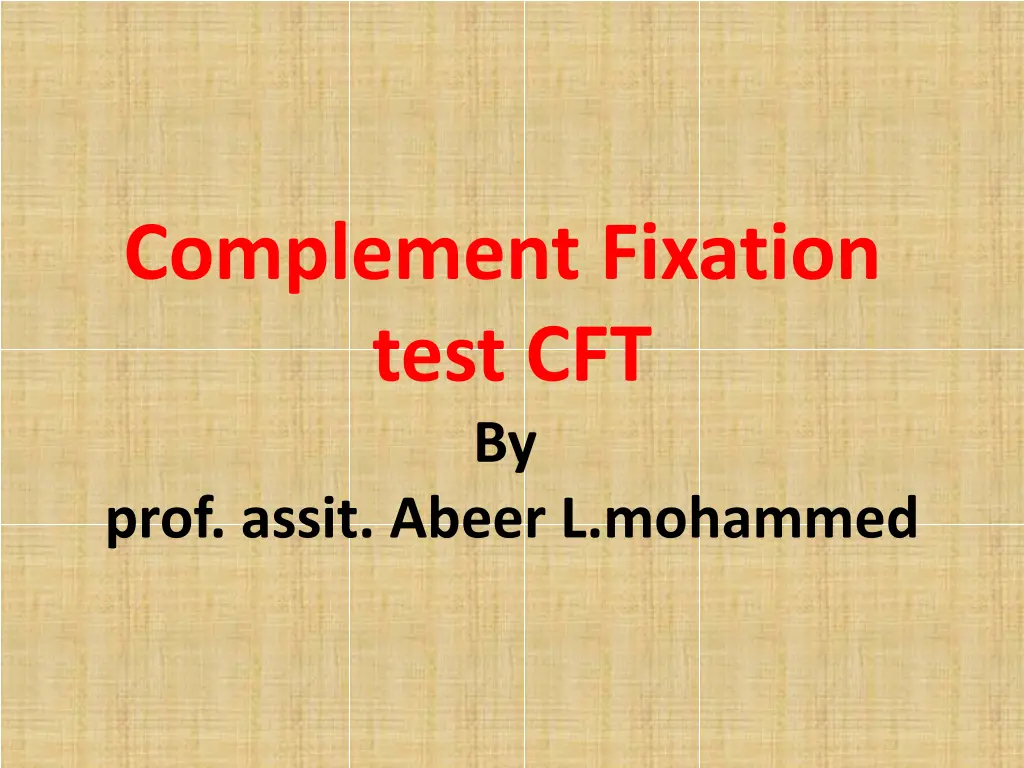
Understanding Complement Fixation Test (CFT) Procedure and Interpretation
Learn about the Complement Fixation Test (CFT) by Prof. Abeer L. Mohammed. Discover the components of the test system, principle, procedure, negative and positive test outcomes, as well as result interpretations. Understand how the CFT works and its significance in identifying antigen-antibody complexes.
Download Presentation

Please find below an Image/Link to download the presentation.
The content on the website is provided AS IS for your information and personal use only. It may not be sold, licensed, or shared on other websites without obtaining consent from the author. If you encounter any issues during the download, it is possible that the publisher has removed the file from their server.
You are allowed to download the files provided on this website for personal or commercial use, subject to the condition that they are used lawfully. All files are the property of their respective owners.
The content on the website is provided AS IS for your information and personal use only. It may not be sold, licensed, or shared on other websites without obtaining consent from the author.
E N D
Presentation Transcript
Complement Fixation test CFT By prof. assit. Abeer L.mohammed
Complement Complement is a protein (globulin) present in normal serum. Whole complement system is made up of nine components: C1 to C9 Complement proteins are heat labile and are destroyed by heating at 56 C for 20 30 minutes. Complement binds to Ag-Ab complex When the Ag is an RBC it causes lysis of RBC s.
Components of CFT Test System Antigen: It may be soluble or particulate. Antibody: Animal serum (May or may not contain Antibody towards specific Antigen) Complement: It is pooled serum obtained from 4 to 5 guinea pigs. It should be fresh or specially preserved as the complement activity is heat labile (stored at -30 C in small fractions). The complement activity should be initially standardized before using in the test. Indicator System (Haemolytic system) Erythrocytes: Sheep RBC Anti RBC (Hemolysin): Rabbit antibody to sheep red cells prepared by inoculating sheep erythrocytes into rabbit under standard immunization protocol.
Principle It is the nature of the complement to be activated when there is formation of antigen-antibody complex. The first step is to heat the serum at 56 C to destroy patient s complement. A measured amount of complement(guinea pigs) and antigen are then added to the serum. If there is presence of antibody in the serum, the complement is fixed due to the formation of Ag-Ab complex. If no antibody is present then the complement remains free. To determine whether the complement has been fixed, sheep RBCs and antibodies against sheep RBCs are added.
Negative Test Step 1: At 37 C Antigen + Antibody absent + Complement Complement not fixed 1 Hour Step 2: At 37 C Free Complement + Haemolytic system Haemolysis 1 Hour (Test Negative)
Positive Test Step 1: At 37 C Antigen + Antibody + Complement (from serum) Complement gets fixed 1 Hour Step 2: At 37 C Fixed Complement complex + Haemolytic system No Haemolysis 1 Hour (Test Positive)
Results and Interpretations: No haemolysis is considered as a positive test. haemolysis of erythrocytes indicative of a negative test. 1 2 3 4 A B Microtiter plate showing Haemolysis (Well A2, A3,A4 and B4) and No Haemolysis (Well A1,B1,B2 and B4)
References Sayeed Ismail Khatib Lecturer Microbiology & Immunology Ibn Sina National College for Medical Studies
